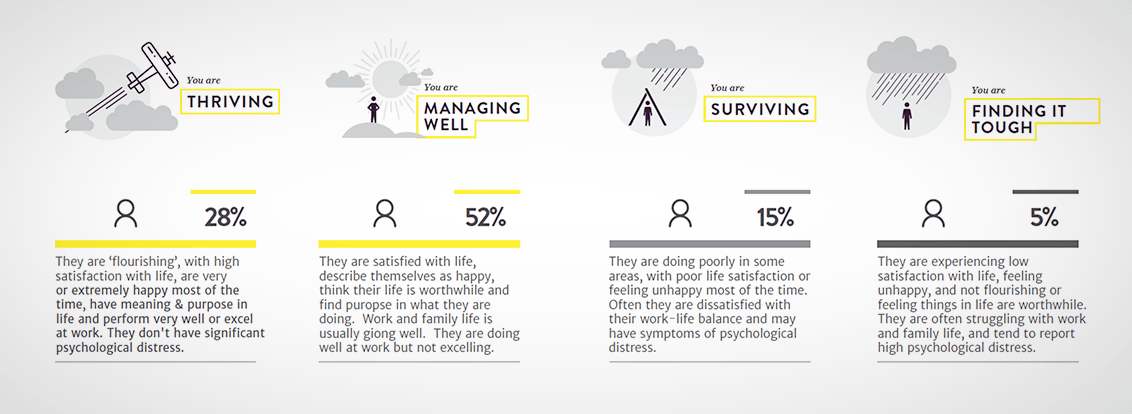Guidance from WorkSafe New Zealand regarding the Health and Safety at Work Act 2015 highlights that organisations hold a duty of care to monitor the health of their employees and to “identify potential signs of potential harm to their health”.
We might think that this only applies to risks to physical health, but under the H&S Act this duty of care very clearly includes mental health and emotional wellbeing as well.
Worksafe guidance describes the process of health monitoring:
Health monitoring involves specific and targeted testing of the health of workers to identify potential signs of potential harm to their health and any changes on an ongoing basis. As well as identifying the development of work-related conditions, the purpose of monitoring is to assess the effectiveness of control measures designed to minimise potential harm to worker health on an ongoing basis.
Specifically, a PCBU (person conducting a business or undertaking) must ensure, so far as is reasonably practicable:
that the health of workers and the conditions at the workplace are monitored for the purpose of preventing injury or illness of workers arising from the conduct of the business or undertaking.
The important questions, then, are that if businesses are required to monitor the mental health and wellbeing of their employees, what does that actually mean and what are the most effective ways to carry out this monitoring?
How are you monitoring staff wellbeing?
We suspect that most businesses are relying on managers and people leaders to monitor staff wellbeing via spotting signs of concern, often in a very ad hoc and unsystematic way. However, this approach can only be one source of data and, in our experience, is not always consistent or reliable. If managers are busy with organisational priorities or feeling overwhelmed themselves, they may miss signs of distress in their people or notice them but feel unable to proactively follow up.
Other sources of information include sick leave, staff turnover and EAP usage. These can be useful, but are likely to underrepresent the true incidence of problems and are rather indirect measures of what is really needed – a measure of the mental health and wellbeing of all employees. Also, we have no way of delineating if a sick day or EAP session has been used proactively to support wellbeing, or reactively due to experiencing difficulties.
Preventing psychological harm
Under the prevention requirement of the Act, businesses also need to be collecting and tracking their own data on the workplace factors that can create potential psychological harm. Research studies have clearly demonstrated that workplace factors can have a significant impact on employee mental health and wellbeing. These workplace factors include:
- organisational change
- work demand overload
- lack of autonomy in how they do their work
- lack of peer and managerial support
- lack of role clarity
- job dissatisfaction.
In contrast, factors that positively influence health and wellbeing include employees seeing that their senior leaders prioritise wellbeing, the business having robust policies that are actioned, and employees having supportive supervision relationships.
Effective data gathering for wellbeing
Testing and monitoring need to include asking all employees directly about their health, mental health and wellbeing as well as workplace factors that may be supportive, or sources of stress.
Baseline measurement of the whole workforce ensures that these data are obtained.
In addition, wellbeing assessment enables organisations to track employee wellbeing over time, assess the impact of programmes to improve wellbeing (including measuring ROI), and provide more targeted support to any business units that may need greater assistance.
Globally, there is a shortage of comprehensive wellbeing assessments that holistically measure mental health and wellbeing, and provide useable information for organisations and individual participants. Generally, marketed assessments are utilised for research purposes or primarily focus on physical health.
In response to requests from our clients and a clear service delivery gap, therefore, Umbrella has developed a comprehensive wellbeing assessment. The Umbrella Health and Wellbeing Assessmentis designed to provide organisations and leaders with a clear picture of the health and wellbeing of your employees. It quickly and effectively identifies teams or individuals who are struggling or languishing, and ensures effective and targeted follow-up can be provided immediately to ensure improvements follow, in accordance with the H&S Act’s duty-of-care expectations. It also identifies employees who are flourishing—equally important for organisations to know, to support these employees to maintain their optimal state and potentially to act as influencers in the organisation.
The assessment is designed to be administered quickly and simply and, in our experience, it is useful to measure at several time points throughout the year.
Contact us to find out more [email protected]



